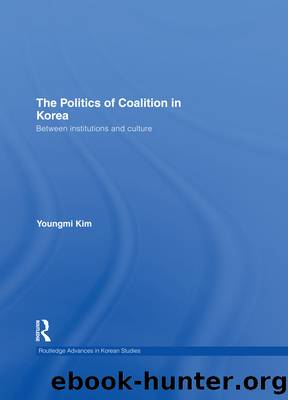The Politics of Coalition in Korea: Between Institutions and Culture by Youngmi Kim

Author:Youngmi Kim [Kim, Youngmi]
Language: eng
Format: epub
Tags: Ethnic Studies, Social Science, Political Parties, Political Science, Political Process, American Government, Regional Studies, General
ISBN: 9781136755163
Google: C8GsAgAAQBAJ
Goodreads: 17551201
Publisher: Routledge
Published: 2011-04-05T00:00:00+00:00
Votersâ Behaviour
After democratization, a clear political, personal and regional cleavage started to emerge in the presidential elections. The two Kims (Kim Young-sam and Kim Dae-jung) had built charismatic leadership within the anti-authoritarian movement as opposition party leaders during the military government, as I have shown in Chapter 2. When South Korea finally achieved electoral democracy, the population, expecting a major political change from authoritarian rule, hoped that the two Kims would cooperate in the presidential elections and compete against Roh Tae-woo, the presidential candidate from the ruling Democratic Justice Party. Kim Dae-jung announced he would not take part in the electoral competition so as to leave a single candidate from the biggest opposition party (the then-New Korea Democratic Party) to compete with the ruling party. Due to the internal competition between the two leaders within the NKDP, however, Kim Dae-jung left the party and announced he would become a presidential candidate. As voters in favour of a change of government were split into two camps, Roh Tae-woo won the presidential election. Opposition figures Kim Dae-jung and Kim Young-sam were severely criticized by the public for losing the chance of shifting power from the authoritarian government to a civilian one because of their personal rivalry (Kim 2001: 234).
Both Kims gained high support from their own respective hometowns: Kim Dae-jung from Honam and Kim Young-sam from Yeongnam respectively. In essence, the conflict between the two over power was nothing new and could also be used strategically by other competing parties. In fact, the ruling party seemed to fuel the rivalry between the two leaders. One of the ruling partyâs evident strategies to hinder the integration of the opposition parties, especially between the two Kims, emerged when the politicians took part in the discussions on revising the constitution after the 6.29 declaration (Kim 2001: 226â227). The ruling and opposition parties had different opinions on many articles of the constitution based on their own interests. For example, when they finally agreed to set five years as the term of a single presidency, the next issue consisted of introducing the position of vice-president into the presidential system. This meant that, should the opposition New Democratic Party win the election, the two Kims would share the posts of president and vice-president in the first term and switch roles in the next presidential election without any power struggles. This new institutional framework could have helped the opposition party integrate more than before. Had the two integrated within the same party and succeeded in the election with a president and vice-president institutional format, the party system in South Korea would presumably have been different, and a new social cleavage rather than regionalism may have emerged. On the other hand, as the post of vice-president was not introduced, the two Kimsâ struggle over becoming the presidential candidate became obvious. The conflict between the two Kims was just what the ruling party wanted to achieve for the continuance of their own power and they were very successful in this strategy.
The
Download
This site does not store any files on its server. We only index and link to content provided by other sites. Please contact the content providers to delete copyright contents if any and email us, we'll remove relevant links or contents immediately.
The Secret History by Donna Tartt(18860)
The Social Justice Warrior Handbook by Lisa De Pasquale(12143)
Thirteen Reasons Why by Jay Asher(8800)
This Is How You Lose Her by Junot Diaz(6802)
Weapons of Math Destruction by Cathy O'Neil(6152)
Zero to One by Peter Thiel(5692)
Beartown by Fredrik Backman(5609)
The Myth of the Strong Leader by Archie Brown(5429)
The Fire Next Time by James Baldwin(5252)
How Democracies Die by Steven Levitsky & Daniel Ziblatt(5133)
Promise Me, Dad by Joe Biden(5089)
Stone's Rules by Roger Stone(5028)
A Higher Loyalty: Truth, Lies, and Leadership by James Comey(4851)
100 Deadly Skills by Clint Emerson(4845)
Rise and Kill First by Ronen Bergman(4705)
Secrecy World by Jake Bernstein(4652)
The David Icke Guide to the Global Conspiracy (and how to end it) by David Icke(4629)
The Farm by Tom Rob Smith(4442)
The Doomsday Machine by Daniel Ellsberg(4420)
